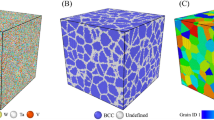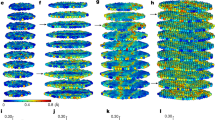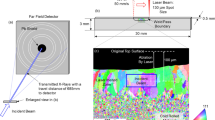Abstract
Shechtman et al.1 have reported a phase in rapidly solidified Al86Mn14 alloy with long-range orientational order, but with icosahedral point-group symmetry, which is inconsistent with lattice translations. However, Pauling2 has argued that the apparent icosahedral symmetry in A186Mn14 alloy is due to directed multiple twinning of cubic crystals with a cube edge of 26.7 Å. We report here the powder X-ray diffraction study of a rapidly solidified Mg32(Al, Zn)49 alloy which shows 5–3–2 symmetry diffraction in transmission electron microscopy (TEM). Also reported is a study of rapidly solidified Mg2A13 alloy. The advantage of these alloys is that β-Mg2Al3, which has nearly the same structure as proposed by Pauling for the rapidly quenched Al86Mn14, is an equilibrium phase. This is unlike the Al–Mn system, where, according to Pauling, the cubic phase occurs in a metastable and already twinned form. The present choice of alloy systems makes it possible to compare the X-ray diffraction patterns from the quasi-crystalline phase and a cubic phase with nearly the same structure as proposed by Pauling. We observe that the X-ray diffraction pattern of rapidly solidified Mg32(Al, Zn)49 alloy is distinct from those of the equilibrium phases and that the pattern can be completely indexed to an icosahedral phase. We argue that the above observation is inconsistent with the proposal that the material consists of an aggregate of twinned cubic crystals. Therefore, the alternative is to invoke a quasi-crystalline lattice to explain the observed 5–3–2 symmetry diffraction in TEM.
This is a preview of subscription content, access via your institution
Access options
Subscribe to this journal
Receive 51 print issues and online access
$199.00 per year
only $3.90 per issue
Buy this article
- Purchase on Springer Link
- Instant access to full article PDF
Prices may be subject to local taxes which are calculated during checkout
Similar content being viewed by others
References
Shechtman, D., Blech, I., Gratias, D. & Cahn, J. W. Phys. Rev. Lett. 53, 1951–1953 (1984).
Pauling, L. Nature 317, 512–514 (1985).
Field, R. D. & Fraser, H. L. Mater. Sci. Engng 68, L17–L21 (1984–85).
Ramachandra, Rao, P. & Sastry, G. V. S. Pramana - J. Phys. 25, L225–L230 (1985).
Bancel, P. A., Heiney, P. A., Stephens, P. W., Goldman, A. I. & Horn, P. M. Phys. Rev. Lett. 54, 2422–2425 (1985).
Bergman, G., Waugh, J. L. T. & Pauling, L. Nature 169, 1056 (1952); Acta crystallogr. 10, 254 (1957).
Samson, S. Nature 295, 259–262 (1962).
Author information
Authors and Affiliations
Rights and permissions
About this article
Cite this article
Rajasekharan, T., Akhtar, D., Gopalan, R. et al. The quasi-crystalline phase in the Mg—Al—Zn system. Nature 322, 528–530 (1986). https://doi.org/10.1038/322528a0
Received:
Accepted:
Issue Date:
DOI: https://doi.org/10.1038/322528a0
This article is cited by
-
Guinier-preston zone, quasicrystal and long-period stacking ordered structure in Mg-based alloys, a review
Acta Metallurgica Sinica (English Letters) (2013)
-
Precipitation and Hardening in Magnesium Alloys
Metallurgical and Materials Transactions A (2012)
-
Improvements of elevated temperature strength and creep resistance of Mg-12Zn-4Al based alloy with calcium addition
Journal of Shanghai Jiaotong University (Science) (2012)
-
Comment on the so-called Z-phase in magnesium alloys containing zinc and rare-earth elements
Journal of Materials Science Letters (1993)
-
Synthesis and structural aspects of quasicrystals in Mg-Al-Ag system: Mg4Al6Ag
Metallurgical Transactions A (1989)
Comments
By submitting a comment you agree to abide by our Terms and Community Guidelines. If you find something abusive or that does not comply with our terms or guidelines please flag it as inappropriate.



